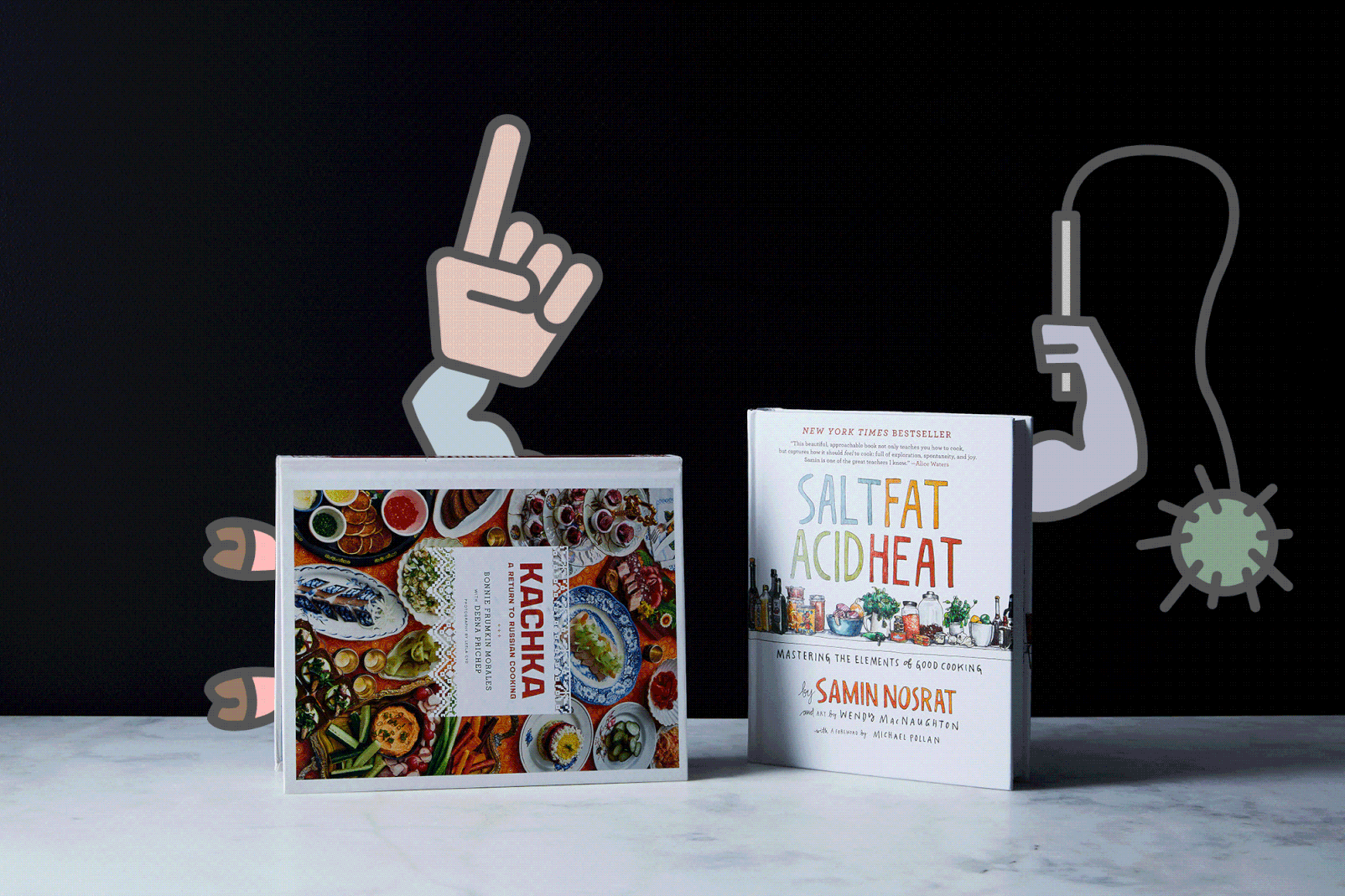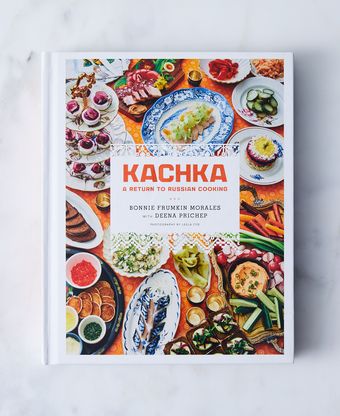I. Kachka
Food can connect us to who we are, who we’ve lost, and where we come from. It can connect us to the world at large—and others who may share parts of our story, without us even knowing it. Food is about giving gratitude for the blessing of being here, now, to enjoy it. Food is love.
And I love Kachka. Author Bonnie Frumkin begins by telling of her family in what is now Belarus—their struggles, tenacity, humor, and love. I heard echoes of my own family’s journey from Sicily in the thoughtful, funny, and sometimes painful memories she shares. But I don’t want to scare anyone off. This book is effin’ cool—it’s both inspiring and a party waiting to happen. It just gets to you. It’s very human.

When I opened the book, I wasn’t familiar with the food of the vast, diverse land of the former Soviet Union, and the many cultures and traditions it encompassed. This is no longer so. I am now a student of a rich history I knew little of, and each page I study in this book makes me warm at heart. For one thing, Bonnie’s introduction states emphatically that “THIS IS NOT A RUSSIAN COOKBOOK.” The recipes are as diverse and complex as the countries they cover, and this is too constricting a term. With this helpful tidbit in mind, I dove in.
Kachka is organized as you would experience courses in a meal: cocktails; pickles; cold and hot appetizers; soups; grilled dishes; entrees; show stoppers; and desserts. I made my way through this book like I was attending a multi-course dinner hosted at the Frumkin house, menu mapped out on a notepad by Bonnie. I didn’t use the primer on Russian groceries and markets in the book, as I was able to source Turkish hot pepper paste and authentic assorted skewers elsewhere. Regardless, I feel I could handle a trip to the market if I consulted Bonnie’s extensive glossary and made a shopping list with it.
Bonnie had us from the start, at the Bloody Masha and Beet Caviar-Stuffed Eggs. My husband, John, makes a hell of a Bloody, and I am deviled egg-obsessed. I have written more than 50 stuffed egg recipes over the years, but was surprised and excited to try Bonnie’s. We loved the spice blend in the Bloody cocktails, perfect for horseradish lovers like us; for this, we owe a thanks to Bonnie’s brother, Simon. Kudos.
As for the deviled eggs, I have always thought “caviar” was specific to fish—not so! In Russia, there is a tradition of minced vegetable caviars, and I am now hooked on the beet variety. Bonnie’s beet caviar-stuffed eggs are filled with a combination of pickled beets, roasted beets, prunes, walnuts, garlic, and parsley mayo. They’re beautiful to look at and delightfully delicious. I garnished mine with shaved radish and celery greens, and added a bit of extra mustard. We made a beautiful lunch buffet centered around these deviled eggs, and filled out the table with Siberian caviar and blini with minced eggs (the byproduct of stuffed eggs), my mom’s chicken livers with chopped parsley, shallot and sprouted wheat toasts, and homemade pickles.

A few weeks later, preparing for a forecast of 70 °F—in February, in Upstate New York—we decided to venture into the world of grilling, Kachka-style. We agreed on the very dish Bonnie made sure was served at her own wedding: Shashlik, or spiced chicken thighs, grilled on a wide metal skewer. I marinated the chicken with chunks of onion in kefir, herbs, and garlic (for John’s tastes) two days before grilling, due more to our own scheduling constraints than the recipe’s instructions. We procured our saber-like skewers the day before our big event, and the next day, John studied the book’s instructions on “How to MacGyver a Mangal” with great excitement. We skewered our chicken and onions and then prepared a magical condiment called Adjika, with herbs, spices, walnuts, and Turkish red pepper paste. Wow!
Next, we made a simple salad, Achichuk, with tomatoes, cucumbers, peppers, and onions; it closely resembled a salad I’ve made a thousand times before, but with the same Turkish pepper paste we loved from making Adjika (I’ve ordered two more jars of it since). The smoky, tangy, tender chicken dinner was perfect, especially with the crunch and freshness of the salad. The meal felt familiar, yet with ingredients and techniques new to us, and was impossible to stop eating. My Sicilian mother took home all the leftover Adjika. At 84, and a lifelong picky eater, she now puts the new-to-her paste on everything: eggs, burgers, and even her finger (ew!).
Kachka is part of our family now. It has given us another way to enjoy life all together—our love of food and each other. My coded message to the author: I am a little duck, forever in your flock.
II. Salt, Fat, Acid, Heat
I regret that I signed up to “judge” anything as subjective as the work of great writers or great chefs, let alone both at once. How did I get here? As I read this book, I kept thinking that I am not qualified to comment on work like this. You cannot judge a book more than 17 years in the making. Its existence and completeness defies judgment. Nonetheless, I had to try.
I have been working in restaurants since I was a small child. One of my first memories in life is grilling my thumb on a flat top griddle, as I reached for a spatula while trying to mimic my mom in the kitchen. The scar is still there today, decades later, marking my right thumb. It reminds me that in the years since that scar, I have shared thousands of recipes, and have helped people put food on a plate that they can be proud of. I love teaching people, and am convinced that if I can cook, anyone can. And so I felt right at home l when I read the first sentence in Samin’s introduction: “Anyone can cook anything and make it delicious.” In Salt, Fat, Acid, Heat, Samin schools me in what I’ve been teaching for two decades. She put everything I have felt, guessed, learned, or taught (in more than 20 books) in one place—and in fewer than 450 pages, at that.
Samin offers a simple, straightforward, often funny, totally complete education in food and cooking. She presents these lessons in a manner that is easy to digest, and that keeps the reader hungry for more. In these pages, she captures the beauty and joy of working in the kitchen, and the pride and satisfaction that comes from preparing (and repairing) food.
The endpapers of Salt, Fat, Acid, Heat alone make this book a “must” for every kitchen shelf, with Wendy MacNaughton’s detailed illustrations of kitchen and pantry essentials. And the rest of her art throughout the book, both beautiful and informative, adds another layer of flavor and complexity; the “World of Acid Wheel” blew my mind, and it looks like a great vinyl album cover. Because I love to draw, and often send thank-you notes with my own recipes portrayed in photographs and illustrations, I especially appreciated the visual aspects of this book. At some points, I literally squealed and giggled with delight.

We cooked several recipes from Salt, Fat, Acid, Heat and found many in the collection that were very familiar to us as a family. We made the Grilled Artichokes, Pasta al Ragù, and the Shaved Fennel and Radishes Salad, all in the same day. We smoked the artichokes in our wood oven as an appetizer for pizza night, and served them with charred lemon halves and a batch of the Mint Salsa Verde. The meat ragù was almost identical to our family recipe—adding Parm rind, as Samin suggests, is such a flavor boost for ragùs and soups alike. We did add in a few ounces of leftover prepared chicken livers to the sauce, as my family often includes them, finely chopped, in beef and pork sauces. We also threw in a fat clove or two of extra garlic—we’re often guilty of overusing it. While the recipe suggests serving the ragù with tagliatelle, penne, or rigatoni, we chose bucatini, because, is there any food more fun to eat than sucking up bucatini covered in meat sauce? Oh, and as extra credit, we made a pot of white beans and topped it with Samin’s Fried Sage Salsa Verde—brilliant!
I am not ordering Salt, Fat, Acid, Heat in multiple copies for friends and family members online. No, I am not. I am going to give this book the respect it deserves and walk to my local bookstore, The Strand, to buy half a dozen copies in person. (Then, I’ll go to nearby Union Square Greenmarket for food.)
III. Decision
In the end, I have to report that each of these titles is essential for different reasons. I love both of them. I think I will cook more from Kachka in the year to come, as this world of food is so new to me, but I will visit with the art and wisdom of Salt, Fat, Acid, Heat many times as well. Kachka wins, narrowly.
P.S.: When I go to The Strand for Salt, Fat, Acid, Heat, I’m buying several copies of Kachka as gifts, too. I better bring John to help me carry them all.



32 Comments
I am a huge fan of Samin Nosrat (my BFF in my head) and SFAH, so I'm very surprised by the outcome.
Note to F52 editors: As much as I love the contest, it seems your heart isn't in it this year.
I already own SFAH, which I treasure. Kachka I was lucky enough to check out of the local library. I say 'lucky' because after reading through the book carefully, and after reading her review, I realized that, given that I don't live in a major metropolitan center, I would be unable to obtain much of the ingredients or equipment needed short of Amazon. Also, many of the recipes call for multi-day preparation, which really doesn't suit my life or cooking style. I'm glad I didn't waste my money on a lovely cookbook that would just gather dust on my already overcrowded shelves.
So this is a warning, fellow Food52'ers: examine Kachka carefully before you rush out to purchase it.
Yes these types of contests are subjective, which is part of what makes it fun to follow. You know that each reviewer is coming at from their own perspective and they are honest about what drew them to a particular book. The only way for this to be more objective would be to have set criteria which would eliminate some books that are just outside the norm. Another option is to have more judges for each book and say majority rules, but in mine that is still entirely subjective. Personally I, and I believe many others, just like hearing the opinions of food 'experts' and food lovers. It's then up to each individual to decide if that cookbook is for them, more so than the one who is crowned the winner. Even for the giveaway they are giving away all 16 books not just the winner, which implies to me that Food52 believes all these cookbooks to be winners already.
(Want Kachka now for sure.)
Keeping in mind that one man’s meat is another man’s poison, I try – not always successfully – to avoid being heavily invested in what is going on and just enjoy the ride, wild as it sometimes is. (Remember when Fancy Desserts beat My Paris Kitchen for the top spot?)
Having said that, Rachel Ray may have drawn the short straw with this assignment, which she, unsurprisingly, handled with customary aplomb. She got a well reviewed, intriguing specialty book versus a reference book that
in all likelihood will become a classic, a book most of us – certainly I – thought would end up in the final round at the end of the day.
Wow. Great review.